
Members of the parrot genus Psittacula or Afro-Asian ring-necked parrots, as they are commonly known in aviculture, originate from Africa to South-East Asia. It is a widespread group with a clear concentration of species in south Asia, but also with representatives in Africa and the islands of the Indian Ocean. This is the only genus of Parrot which has the majority of its species in continental Asia. Of all the extant species only Psittacula calthropae, Psittacula caniceps and Psittacula echo do not have a representative subspecies in any part of mainland continental Asia. The rose-ringed parakeet, Psittacula krameri, is one of the most widely distributed of all parrots.

The Puerto Rican emerald, or zumbadorcito de Puerto Rico in Spanish, is species of hummingbird in the "emeralds", tribe Trochilini of subfamily Trochilinae. It is endemic to Puerto Rico.
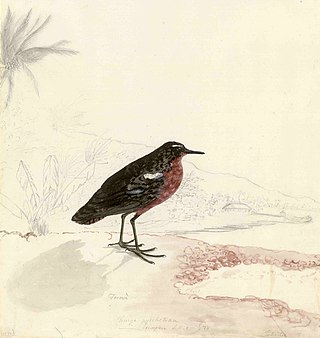
The Tahiti sandpiper or Tahitian Sandpiper is an extinct member of the large wader family Scolopacidae that was endemic to Tahiti in French Polynesia until its extinction sometime before 1819.

The sword-billed hummingbird, also known as the swordbill, is a neotropical species of hummingbird from the Andean regions of South America. It is the only member in the genus Ensifera. Among the largest species of hummingbird, it is characterized by its unusually long bill, being the only bird to have a beak longer than the rest of its body, excluding the tail. It uses its bill to drink nectar from flowers with long corollas and has coevolved with the species Passiflora mixta. While most hummingbirds preen using their bills, the sword-billed hummingbird uses its feet to scratch and preen due to its bill being so long.
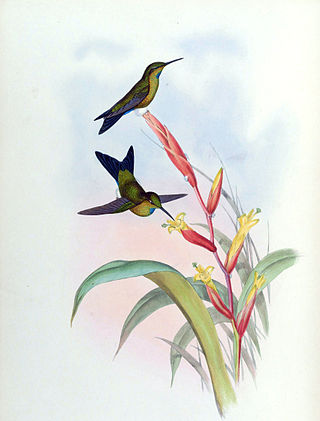
The turquoise-throated puffleg, also known as Godin's puffleg, is a species of hummingbird from Ecuador. It is mostly green with blue undertail coverts and white powder-puffs of downy feathers on the legs, and the male has a bluish-purple throat patch. It is only known from a few specimens taken in the nineteenth century and its taxonomic position is unclear. The type of habitat in which the type species was obtained has largely disappeared, and recent surveys trying to find this bird have failed. The International Union for Conservation of Nature believes it may be extinct, but there is a possibility that some individuals remain, so the bird has been rated as "critically endangered".
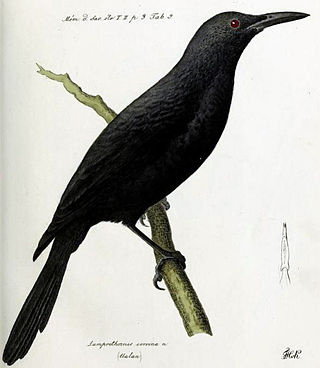
The Kosrae starling, also known as Kosrae Island starling, and formerly as Kusaie Mountain starling, is an extinct bird from the family of starlings (Sturnidae). It was endemic to the montane forests on the island of Kosrae which belong to the Caroline Islands in the south-western Pacific.
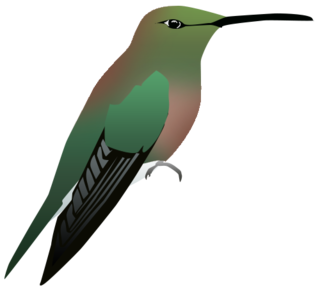
Brace's emerald is an extinct species of hummingbird which was endemic to the main island of the Bahamas, New Providence.

The New Zealand quail, or koreke in Māori, is an extinct quail species endemic to New Zealand. The male and female were similar, except the female was lighter. The first scientist to describe it was Sir Joseph Banks when he visited New Zealand on James Cook's first voyage. Terrestrial and temperate, this species inhabited lowland tussock grassland and open fernlands. The first specimen to be obtained by a European was collected in 1827 by Jean René Constant Quoy and Joseph Paul Gaimard on Dumont D'Urville's voyage. It most likely went extinct due to diseases from introduced game birds.

The Hispaniolan emerald is a species of hummingbird in the "emeralds", tribe Trochilini of subfamily Trochilinae. It is endemic to the island of Hispaniola, which is shared by the Dominican Republic and Haiti.

The blue-headed hummingbird is a species of hummingbird in the "emeralds", tribe Trochilini of subfamily Trochilinae. It is found only on the islands of Dominica and Martinique in the Lesser Antilles.
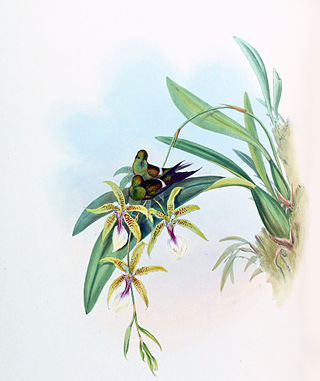
Letitia's thorntail, also known as the coppery thorntail, is a species of hummingbird in the "coquettes", tribe Lesbiini of subfamily Lesbiinae.

The Pirre hummingbird, also somewhat misleadingly known as the rufous-cheeked hummingbird, is a Near Threatened species of hummingbird in the "emeralds", tribe Trochilini of subfamily Trochilinae. It is found in Panama and far northwestern Colombia.
The Bogotá sunangel is a species of hummingbird that is only known from one specimen. The hummingbird is a bright purple with black flight feathers and a bright green chin and crown. This bird has only been found in Colombia and is assumed to live in cloud forest between 1200 and 3400 meters. Most of its potential habitat is degraded, though it is feasible that a population may still exist.

The Chatham rail is an extinct flightless species of bird in the family Rallidae. It was endemic to Chatham, Mangere and Pitt Islands, in the Chatham archipelago of New Zealand.
The Sinú parakeet is a bird in subfamily Arinae of the family Psittacidae, the African and New World parrots. BirdLife International's Handbook of the Birds of the World recognizes it as a full species. The International Ornithological Committee (IOC), the South American Classification Committee of the American Ornithological Society, and the Clements taxonomy treat it as a subspecies of the painted parakeet.

Bauruemys is an extinct genus of turtles in the family Podocnemididae.
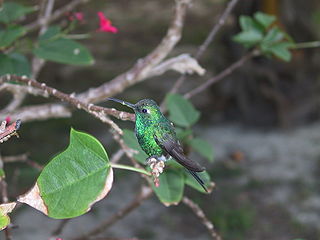
Riccordia is a genus of birds in the hummingbird family Trochilidae. They are endemic to the Caribbean.

The guanacaste hummingbird or Alfero's hummingbird is a possibly extinct species of hummingbird known only from a holotype collected in 1895 at the Miravalles Volcano in Costa Rica.


















